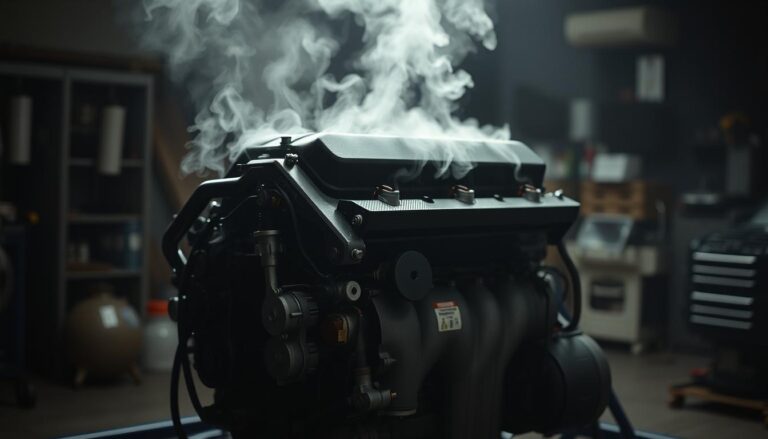A stuck emergency brake can be a frustrating and potentially hazardous issue for vehicle owners. When the emergency brake becomes stuck, it can lead to problems with the overall braking system, compromising safety on the road.
Understanding the common reasons behind a stuck emergency brake is crucial for effective troubleshooting and repair. Issues such as worn-out brake components, corrosion, or improper adjustment can all contribute to this problem.
Addressing a stuck emergency brake is not just about convenience; it’s also about ensuring the vehicle’s safety and preventing potential damage to the braking system.
Key Takeaways
- Identify common causes of a stuck emergency brake.
- Understand the importance of addressing the issue promptly.
- Learn effective troubleshooting steps for emergency brake repair.
- Discover potential fixes for a stuck emergency brake.
- Recognize the role of maintenance in preventing future issues.
Understanding Your Vehicle’s Emergency Brake System
Understanding the intricacies of your vehicle’s emergency brake system is essential for identifying and resolving potential issues. The emergency brake, also known as the parking brake, plays a crucial role in ensuring vehicle safety.
How Emergency Brakes Work
The emergency brake system operates by using a separate mechanism from the primary braking system to immobilize the vehicle. This is typically achieved through a cable or electronic system that applies pressure to the brake calipers or a dedicated drum brake at the rear wheels.
Types of Emergency Brake Mechanisms
There are primarily two types of brake mechanisms used in vehicles: mechanical and electronic. Mechanical systems rely on cables and levers to activate the brake, while electronic systems use motors and sensors to apply the necessary pressure. Understanding which type your vehicle uses is crucial for effective troubleshooting.
Emergency Brake Is Stuck: Popular Causes and Solutions
Dealing with a stuck emergency brake requires understanding its causes and applying the right fixes. The emergency brake, a crucial safety feature, can become stuck due to various reasons. Identifying the cause is the first step towards resolving the issue.
Rust and Corrosion
Rust and corrosion are common culprits behind a stuck emergency brake. Moisture can cause the brake’s mechanical components to corrode, leading to it getting stuck. Regular cleaning and lubrication can help prevent this. If corrosion is already present, it may be necessary to replace the affected parts.
Cable Issues and Breakage
The cables connected to the emergency brake can become worn out or broken, causing it to stick. Inspecting the cables for any signs of wear or damage is crucial. Replacing damaged cables can often resolve the issue. It’s also important to ensure that the cables are properly adjusted.
Frozen Components in Cold Weather
In cold climates, components of the emergency brake can freeze, causing it to stick. This is often due to moisture accumulation. Using a de-icer or applying heat can help thaw out the frozen parts. Ensuring that the brake system is properly lubricated can also help prevent freezing.
Mechanical Failures in the Brake Assembly
Sometimes, the issue lies within the brake assembly itself. Mechanical failures can occur due to wear and tear or manufacturing defects. Inspecting the brake assembly for any signs of failure is essential. Repairing or replacing the faulty components can resolve the issue.
Understanding these common causes and applying the appropriate solutions can help you address a stuck emergency brake effectively. Regular maintenance is key to preventing such issues.
Safety Precautions Before Troubleshooting
Ensuring your safety is paramount when dealing with a stuck emergency brake. Before diving into the troubleshooting process, it’s essential to prepare your environment and yourself for the task.
Required Tools and Equipment
Having the right tools and equipment is crucial for safe and effective troubleshooting. You’ll need a set of basic tools such as wrenches, pliers, and lubricants. Additionally, safety gear like gloves and safety glasses can protect you from potential hazards.
| Tool/Equipment | Purpose |
|---|---|
| Wrenches | For loosening stuck parts |
| Pliers | For gripping small components |
| Lubricants | For reducing friction and corrosion |
Vehicle Stabilization Methods
Proper vehicle stabilization is critical to prevent accidents during troubleshooting. Ensure the vehicle is on a level surface and apply the parking brake (if it’s not the brake you’re troubleshooting). Use jack stands for added safety when working under the vehicle.

DIY Solutions for a Stuck Emergency Brake
A stuck emergency brake is not just an inconvenience; it’s a safety issue that can be addressed with the right DIY techniques. Before you consider taking your vehicle to a mechanic, there are several steps you can take to try and resolve the issue on your own.
Releasing a Frozen Brake
One common reason for a stuck emergency brake is freezing, especially in cold weather. To release a frozen brake, you can try a couple of methods.
Using Penetrating Oil and Lubricants
Applying penetrating oil or lubricants can help loosen the frozen parts. Spray the lubricant onto the brake mechanism and let it sit for a few minutes before attempting to release the brake. For more information on handling stuck parking brakes, you can visit Firestone Complete Auto Care.
Applying Controlled Force Techniques
If lubricants don’t work, you may need to apply some controlled force. Gently rock the vehicle back and forth while attempting to release the brake. Be cautious not to apply too much force, which could damage the brake system.
Cable Adjustment and Replacement
Sometimes, the issue isn’t freezing but rather a misadjusted or damaged cable. Checking and adjusting the emergency brake cable can often resolve the problem. If the cable is damaged, it may need to be replaced. This involves loosening the tensioner, removing the old cable, and installing a new one, making sure it’s properly tensioned.
Cleaning Rust and Debris from Mechanisms
Rust and debris accumulation is another common cause of a stuck emergency brake. Cleaning the brake mechanism with a wire brush and some solvent can help remove rust and grime. After cleaning, apply some lubricant to prevent future sticking.

By following these DIY solutions, many vehicle owners can successfully fix a stuck emergency brake. However, if the problem persists, it may be time to seek professional help.
Vehicle-Specific Troubleshooting Approaches
Vehicle-specific troubleshooting is crucial for effectively addressing a stuck emergency brake issue. Different vehicles have unique emergency brake systems, and understanding these differences is key to successful repair.
Sedan and Compact Car Procedures
For sedans and compact cars, the emergency brake system is often mechanically operated. Troubleshooting typically involves checking the brake cable for signs of wear or damage and ensuring that the brake mechanism is not frozen due to rust or corrosion. Regular maintenance, such as lubricating the brake cable and mechanism, can prevent issues.
SUV and Truck Emergency Brake Systems
SUVs and trucks may have more complex emergency brake systems, sometimes featuring electronic controls. When troubleshooting, it’s essential to consult the vehicle’s manual or a repair database for specific guidance. Common issues include faulty sensors or worn brake components.
Electronic Parking Brake Troubleshooting
Vehicles equipped with electronic parking brakes require specialized troubleshooting. This may involve using diagnostic equipment to check for error codes or performing specific reset procedures. Refer to the vehicle’s repair manual for detailed instructions.
| Vehicle Type | Common Issues | Troubleshooting Tips |
|---|---|---|
| Sedans and Compact Cars | Worn or damaged brake cables, frozen mechanisms | Lubricate brake cables, inspect for corrosion |
| SUVs and Trucks | Faulty sensors, worn brake components | Consult vehicle manual, check for error codes |
| Electronic Parking Brakes | Software issues, faulty actuators | Use diagnostic equipment, perform reset procedures |
When to Seek Professional Help
If your attempts to fix the stuck emergency brake have been unsuccessful, it may be time to consider seeking professional help. While DIY solutions can be effective for minor issues, more complex problems require the expertise of a professional mechanic.
Signs of Serious Mechanical Issues
Certain signs indicate that your stuck emergency brake is more than just a simple fix. These include unusual noises when attempting to release the brake, visible damage to the brake cables or surrounding components, and uneven wear on the brake pads or rotors. If you notice any of these symptoms, it’s crucial to seek professional help to avoid further damage to your vehicle’s braking system.
Cost Estimates for Professional Repairs
The cost of professional repairs for a stuck emergency brake can vary widely depending on the nature of the issue and the type of vehicle you own. On average, you can expect to pay between $100 and $300 for labor and parts. For more complex repairs, such as replacing the brake cable or repairing damaged brake components, costs can range from $300 to $500 or more. It’s essential to get a detailed estimate from your mechanic before proceeding with the repairs.
Conclusion
A properly functioning emergency brake system is crucial for brake safety. Regular emergency brake maintenance can help prevent accidents and ensure vehicle stability.
By understanding the causes of a stuck emergency brake and following the DIY solutions and troubleshooting approaches outlined in this article, vehicle owners can take proactive steps to maintain their vehicle’s brake system.
Regular inspections and maintenance can help identify potential issues before they become major problems, reducing the risk of accidents and costly repairs. Prioritizing emergency brake maintenance is essential for overall brake safety.
FAQ
What are the common causes of a stuck emergency brake?
Common causes include rust and corrosion, cable issues and breakage, frozen components in cold weather, and mechanical failures in the brake assembly.
How do I troubleshoot a stuck emergency brake in my vehicle?
Start by understanding your vehicle’s emergency brake system, then identify the cause of the issue, and apply the relevant DIY solution or seek professional help if needed.
Can I fix a stuck emergency brake on my own?
Yes, many issues can be resolved through DIY methods such as releasing a frozen brake, adjusting or replacing cables, and cleaning rust and debris from mechanisms.
What safety precautions should I take before troubleshooting my emergency brake?
Ensure you have the required tools and equipment, and properly stabilize your vehicle to avoid accidents or injuries.
How do I know if my vehicle’s emergency brake issue requires professional attention?
Look for signs of serious mechanical issues, and consider the cost estimates for professional repairs to determine the best course of action.
Are there vehicle-specific approaches to troubleshooting an emergency brake?
Yes, different vehicles such as sedans, SUVs, trucks, and those with electronic parking brakes may require unique troubleshooting approaches.
What are the benefits of maintaining a functional emergency brake system?
A functional emergency brake system is crucial for safety, as it helps prevent accidents and ensures the vehicle remains stable when parked or in emergency situations.
Can penetrating oil and lubricants help release a frozen emergency brake?
Yes, using penetrating oil and lubricants can be an effective method to release a frozen brake, as they help loosen corroded or stuck components.


